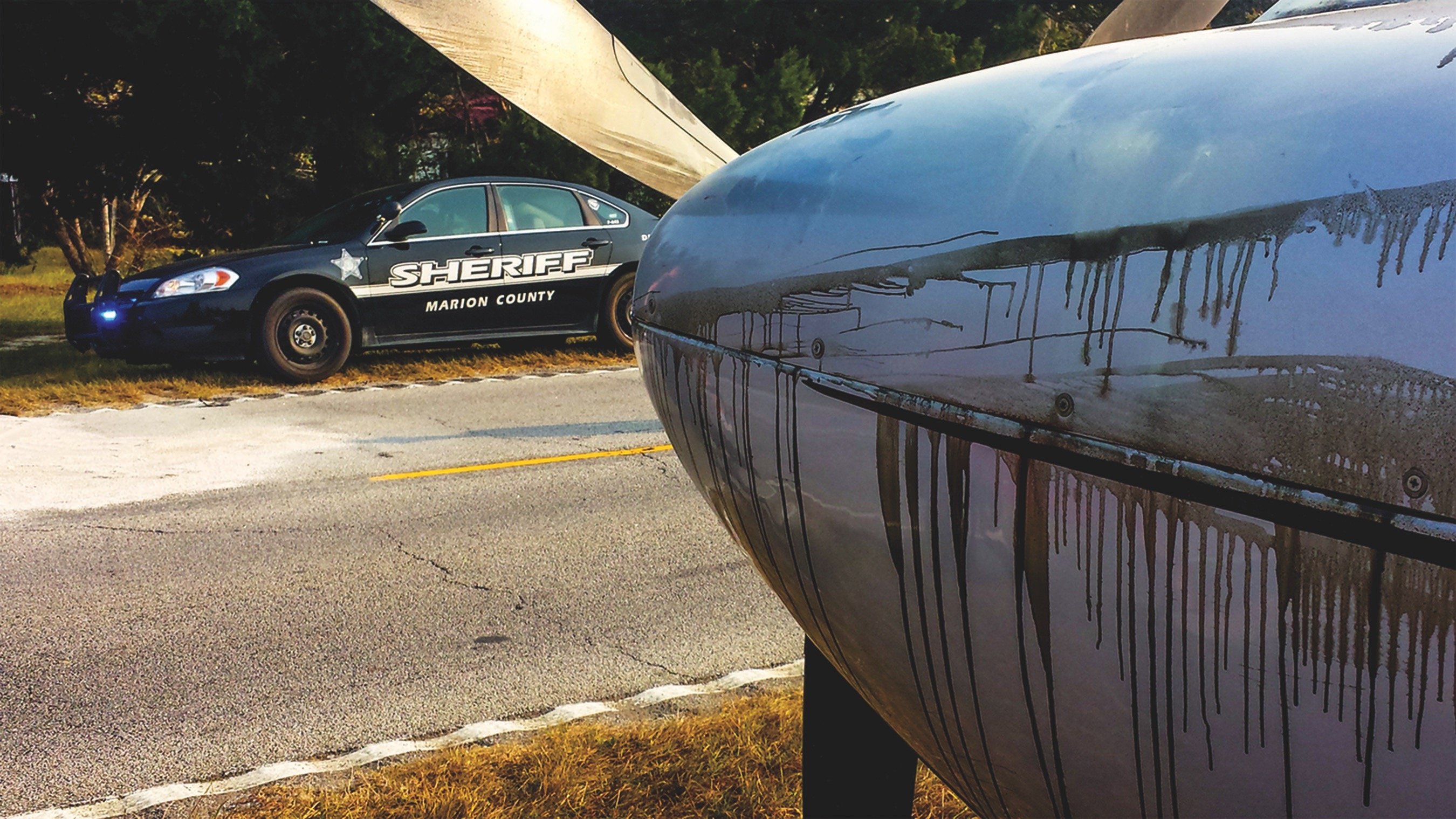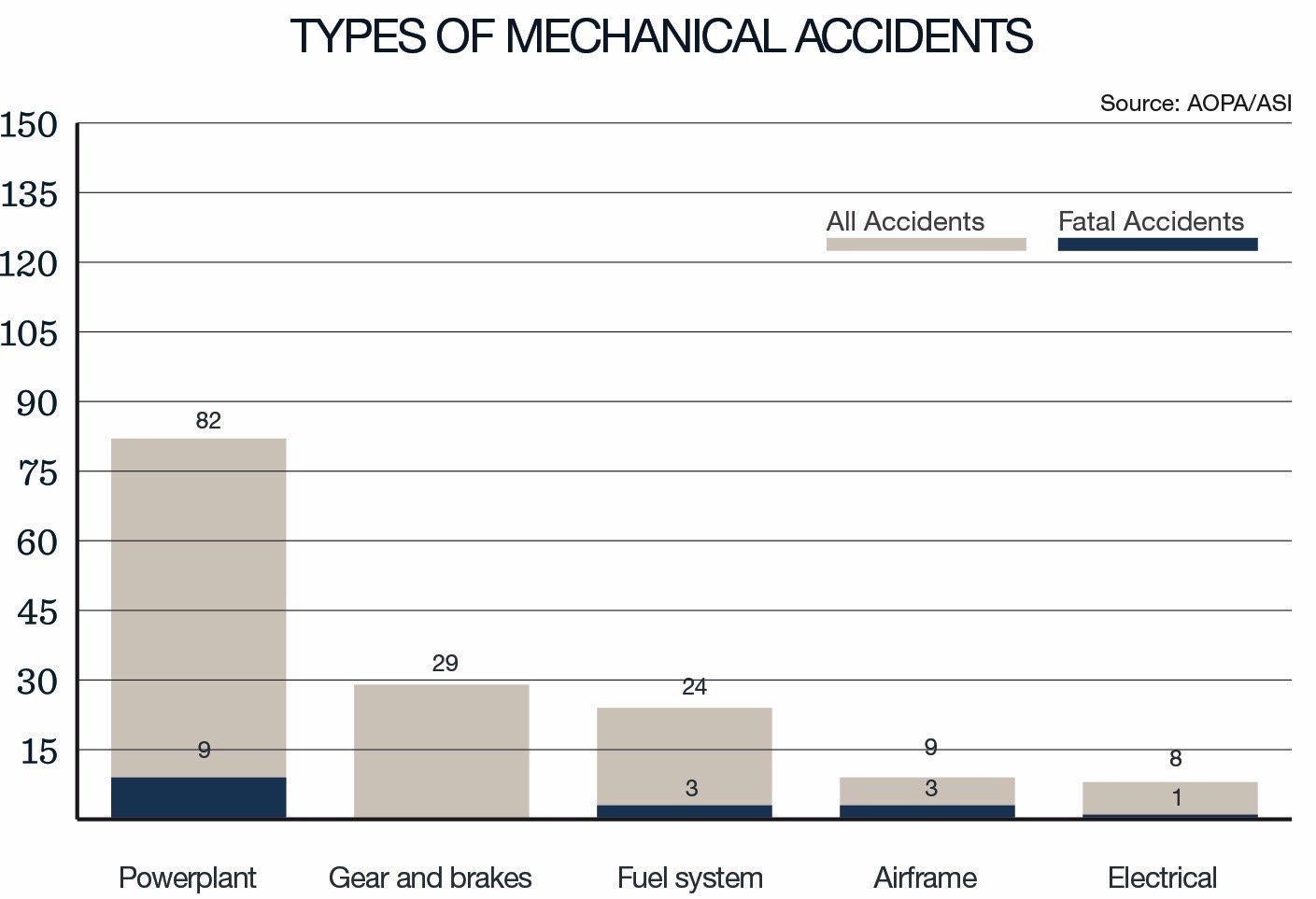Almost from the beginning of our flight training, pilots are drilled on simulated engine failures in every phase of flight. Once we’re introduced to dealing with engine failures, we practice and perfect them, and then revisit them to ensure proficiency. This training is necessary because, although generally reliable, small airplane engines do still fail, especially if they are piston engines. Good inspection and maintenance practices plus proper operation help minimize or eliminate the risk.
However, the likelihood (probability) of an engine failure and even its severity (consequences) can be managed ahead of time so that a failure might be less likely and, if one does happen, you might be in a better position to land without injury and maybe without damage.
Viper Flight Training

So…What’s the risk?
Before taking steps to minimize the risk of engine failures, we probably should try to quantify it. Thanks to the way U.S. aviation mishaps are cataloged, it’s safe to say that engine failures happen more often than the data reflect. The sidebar at the bottom of the opposite page goes into greater detail, but it’s safe to say engine failures that don’t result in substantial damage, serious injury or death aren’t part of the data. In fact, the NTSB’s definitions specifically exclude “[e]ngine failure or damage limited to an engine if only one engine fails or is damaged….” The punchline is that official data underestimate the actual and unknown engine-failure rate. Personal experience bears this out.
So, we can presume the actual engine-failure rate—and our risk—is greater than demonstrated. That’s the bad news. The good news is we also can presume that some number of engine-failure events didn’t result in substantial damage, serious injury or death. If we’re going to have to deal with an engine failure, what can we do to wind up in the “uninjured, no-damage” category? A lot, it turns out.
Basic Strategy
First, pay heed to what you learned in primary training and should be practicing regularly. An actual engine failure may be unlikely, but it is still possible. Staying proficient with emergency procedures and forced landing techniques is still vital. However, as when dealing with any hazard, a more comprehensive approach to managing engine-failure risk could lead to better outcomes.
Our basic strategy to managing the risk of engine failure starts with our familiar risk management matrix, reproduced at the top of the following page. Once a risk is identified—engine failure in this case—we must analyze it in terms of its likelihood (probability) and its severity (consequences). This will allow us to see the total risk and then point the way to mitigating actions. The objective is to mitigate unacceptably high risks down to lower risk by reducing risk likelihood and/or severity.
What’s an unacceptably high risk? Any high risk (red) must be mitigated to lower either the likelihood or the severity of the risk to produce a lower overall risk level. What if the risk is “merely” at the serious (yellow) level? Good practice and professional standards dictate that this risk also be mitigated. If you look at any airline or corporate flight department, you will find that risk management is ingrained in both aircraft certification standards and operating procedures such that most risks end up being mitigated to the low (white) level. You should always be striving to reduce risk, but as a general aviation pilot you have discretion to accept some risks that our commercial cousins always mitigate.
Managing risk likelihood
Let’s start by analyzing how we can manage risk likelihood for engine failures. An engine failure in a single-engine piston aircraft, while unlikely, is still possible, so the likelihood is firmly in the “remote” line. An engine failure in a turbine-engine single, on the other hand is highly unlikely to occur, hence “improbable.”
Does this mean that you can’t control risk likelihood in your piston single? No. Obviously, you can move the severity needle anywhere within the “remote” bucket so that you are closer to the “improbable” category than you are to the “occasional” level.
Most of us can’t afford the jump to turbine equipment, so what are some actions you can take to reduce engine failure risk likelihood? The following list is heavy on maintenance actions with some operational actions added.
Frequent oil changes. Make sure that the oil filter is inspected for metal and other contaminants and take an oil sample for lab analysis.
Top end inspection. Compression and borescope inspections should be done at least at every other oil change.
Frequent engine inspection. Depending on your level of activity, you might want to conduct detailed engine inspections, using the 100-hour engine checklist for your make and model, more often than at the annual or 100-hour inspection. For example, I fly my Mooney about 160 hours per year. I do oil changes at 40-hour intervals and a 100-hour engine inspection at 80 hours. This event includes compression and borescope inspections. I am now also doing these at the 40-hour interval as the engine approaches its time between overhaul (TBO).
Engine monitoring. Think seriously about having one in your aircraft and using it to evaluate the health of your cylinders and valve train.
Other engine instruments. Even rudimentary engine instruments can be used to detect changes and trends. Is your oil pressure lower than normal and your oil temperature higher? Time to ground the aircraft and investigate.
Managing risk severity
Is there really a way to manage the level of risk severity? Of course. Your primary objective is to prevent fatalities and injuries, with saving the airplane as a secondary objective. In other words, use mitigations that avoid a catastrophic outcome and aims for “negligible” consequences. Here are some key mitigations that could save your life and maybe even the aircraft.
Be proficient. Prevention may be your first line of defense, but this could be your last line of defense. Practice simulated engine failures and know your emergency procedures cold, especially techniques such as best gliding speed.
Maintain situational awareness. Spotting an incipient engine failure in the early stages can allow you to execute a precautionary landing or better position yourself if the engine quits before you’re on the ground.
Install shoulder harnesses. Most aircraft now have them, but if yours doesn’t, install them. Airbags are also available for retrofit on some aircraft.
Fly higher. Altitude buys you time and distance if the engine dies. I typically operate my Mooney between 9,500 to 12,500 feet. From two miles up and a 13:1 glide ratio, I have a 25-mile radius to find an airport or suitable landing spot.
Airframe parachute. This may sound like an ad for Cirrus, but 82 of them have deployed their CAPS chutes within the system’s limits and all the occupants have lived to regale their friends with the story.
Avoid/limit certain profiles. Concerned about operating at night, in IMC, or over or around inhospitable terrain, wilderness, urban areas and water? You should at least factor these into your risk management planning, as described in the next section.
Hazardous profiles
Transportation utility is certainly why I own an airplane, but we should consider what hazards and risks we face from potential engine failures in certain extreme and not-so-extreme settings. Below are a few settings that I consider during my preflight planning and in-flight risk management. Your assessments of these settings may vary from mine, and that is part of your prerogative, if you do so consciously.
Night. Night operations have historically been more hazardous than daylight flights. From an engine failure perspective, the likelihood doesn’t change, but the ability to mitigate risk severity is compromised because of restrictions on seeing potential landing sites. My own mitigation is that I will not initiate a night flight in a single-engine piston, except under the most benign conditions (good visibility, full moon, favorable terrain). I will continue a flight into darkness if conditions are favorable, but will fly high to increase the chance of reaching an airport if the engine fails.
Low IFR/IMC. In a piston single, I will initiate a flight into low IFR if the IMC is localized. I will also continue a flight into low IFR if it only exists around the destination or in scattered areas along the route. I won’t initiate a flight where the flight path is totally within a low-IFR system.
Inhospitable terrain. When flying over poor terrain, I will try to fly as high as practical, such that my “rocky footprint” is eliminated or minimized. That is, I would be able to glide to an airport or suitable landing area in the event of an engine failure.
Water. Most single-engine aircraft can be ditched in a manner that will usually not injure the occupants. The risk comes from being able to escape the aircraft and then surviving in a water environment until rescued. I have made three trips to the Bahamas carrying only life jackets, but I would no longer do such a trip in a single piston unless I had a raft, signaling gear and other survival equipment.
Wilderness. Even if over terrain where a forced landing or ditching could be made without injury, these operations demand full survival gear and training on how to use it. The main problem is not being near any rescue options. In two trips to Alaska (one in a Mooney and the other in a Bonanza), I’ve followed all three common routes: the Alaska Highway, the Trench and the coastal route. I had full survival gear and knew how to use it. On any future trip, however, I will stick to the Alaska Highway route when operating a piston single.
Urban environments. Many large city cores are almost exclusively hostile to a successful forced landing (ask Sully for confirmation). Many pilots are based in dense urban areas where the airport itself is surrounded by houses and other buildings and obstacles. I’m not based in an urban environment, but when flying to such locations, I try to do a little additional risk management planning. For example, is there a different airport that I could use with a longer runway?
In nearly 10,000 hours of flying, I have never had an engine failure. Hopefully, that will continue and your experience will be the same, but it’s always better to be prepared.
Robert Wright is a former FAA executive and president of Wright Aviation Solutions LLC. He is also a 9800-hour ATP with four jet type ratings, and he holds a Flight Instructor Certificate. His opinions in this article do not necessarily represent those of clients or other organizations that he represents.

Two Kinds of Engine Failures
You will be way ahead of the risk management game if you can avoid all the pilot-induced reasons that engines stop. These include fuel exhaustion and fuel starvation, carburetor icing and other causes where the risk can be mitigated through better preflight planning, checklist use and other procedures. We also can talk about regular inspection and maintenance, and proper operation. From experience, if the engine’s healthy, keeping it that way isn’t much of a problem. Get to know your engine monitor—you do have one, right?—and learn to manage your engine.
Once we eliminate the easy stuff, we’re down to actual mechanical failure of some powerplant component. In these cases, the extent of powerplant failure depends on which component fails. For example, catastrophic failure is the usual outcome for piston-engine crankshaft, connecting rod and oil pump failures. Fortunately, such failures are extremely rare. On the other hand, failures of pushrods, magnetos, pistons and rings are more likely—but still low—and may only cause a power reduction.


The Aircraft Owners and Pilots Association (AOPA) Air Safety Institute (ASI) recently published its latest annual Nall Report, analyzing fatal and non-fatal general aviation accidents. The 2018 Nall Report looks at NTSB data beginning with 2006 through 2015. It breaks down accident causes into three major categories: pilot-related, mechanical and other or unknown (top right). The data shown are for 2015 alone.
In 2015, mechanical reasons were ascribed to 15.7 percent of non-commercial fixed-wing accidents, earning them a distant second behind the pilot-related category. Of them, 82 (54 percent) involved the powerplant. Only nine (11 percent) of the powerplant failures during 2015 were fatal, meaning we basically have a one-in-ten chance to survive an accident resulting from an engine failure. As this article’s main text explains, however, some unknown number of engine failures do not result in a reportable accident.
Viper Flight Training

What’s your approach to managing the risk of engine failure?
All pilots have different tolerance for risk and are permitted to exercise discretion when operating under Part 91. Nevertheless, there are certain ground rules we should always follow to mitigate potential engine failures.
Always conduct risk management for all flights. In complex situations, use a flight risk assessment tool (FRAT) to identify, assess and mitigate risk.
If any identified risk is assessed as high (red) and cannot be mitigated, don’t launch until it can be mitigated.
If any identified risk is assessed as serious (yellow), then make every effort to mitigate it to lower levels. If you cannot mitigate a yellow risk and still decide to launch, remember that you must consciously accept the elevated risk on behalf of yourself, your passengers and possibly those on the ground.
Even medium (green) or low (white) risks should be mitigated where possible.

LIKELIHOOD
Probable: An event will occur several times.
Occasional: An event will probably occur sometime.
Remote: An event is unlikely to occur but is possible.
Improbable: An event is highly unlikely to occur.
For ease of analysis, the risk assessment matrix has only four “buckets” of likelihood or severity. In reality, an event’s outcome occupies a continuum of infinite levels of both likelihood and severity.
SEVERITY
Catastrophic: Results in fatalities or total airframe loss.
Critical: Severe injury or major damage.
Marginal: Minor injury or minor damage.
Negligible: Less than minor injury and less than minor system damage.




